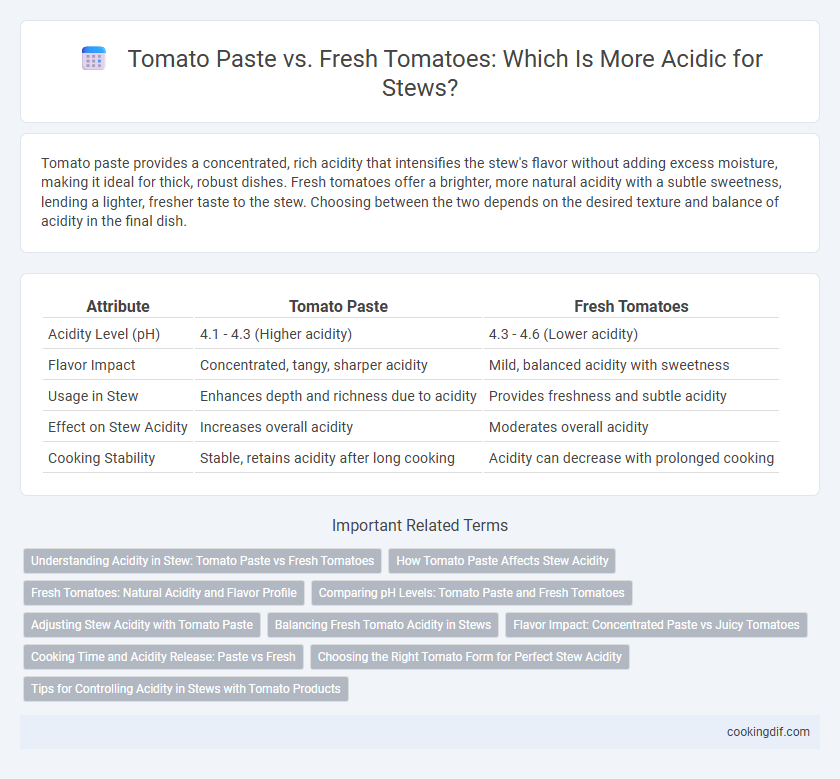Tomato paste provides a concentrated, rich acidity that intensifies the stew's flavor without adding excess moisture, making it ideal for thick, robust dishes. Fresh tomatoes offer a brighter, more natural acidity with a subtle sweetness, lending a lighter, fresher taste to the stew. Choosing between the two depends on the desired texture and balance of acidity in the final dish.
Table of Comparison
| Attribute | Tomato Paste | Fresh Tomatoes |
|---|---|---|
| Acidity Level (pH) | 4.1 - 4.3 (Higher acidity) | 4.3 - 4.6 (Lower acidity) |
| Flavor Impact | Concentrated, tangy, sharper acidity | Mild, balanced acidity with sweetness |
| Usage in Stew | Enhances depth and richness due to acidity | Provides freshness and subtle acidity |
| Effect on Stew Acidity | Increases overall acidity | Moderates overall acidity |
| Cooking Stability | Stable, retains acidity after long cooking | Acidity can decrease with prolonged cooking |
Understanding Acidity in Stew: Tomato Paste vs Fresh Tomatoes
Tomato paste contains concentrated acids that provide a consistent and intense tang, enhancing the stew's depth of flavor without diluting other ingredients. Fresh tomatoes offer a more balanced acidity with natural sugars and moisture that create a milder, fresher taste in the stew. Choosing between tomato paste and fresh tomatoes affects the stew's overall acidity level, richness, and texture.
How Tomato Paste Affects Stew Acidity
Tomato paste intensifies stew acidity by concentrating natural tomato acids, resulting in a robust, tangy flavor that fresh tomatoes typically lack due to their higher water content and milder acidity. The paste's thick consistency enhances the stew's texture while balancing acidity with a rich umami depth. Using tomato paste allows precise control over acidity levels, making it ideal for achieving a well-rounded, flavorful stew.
Fresh Tomatoes: Natural Acidity and Flavor Profile
Fresh tomatoes offer a balanced natural acidity that enhances stew's depth without overpowering other ingredients. Their rich umami and subtle sweetness contribute to a complex flavor profile, making the stew more vibrant and aromatic. Unlike tomato paste, fresh tomatoes provide a fresh, fruity dimension that intensifies the stew's overall taste and texture.
Comparing pH Levels: Tomato Paste and Fresh Tomatoes
Tomato paste typically has a lower pH, ranging from 4.0 to 4.3, making it more acidic than fresh tomatoes, which generally have a pH between 4.3 and 4.9. This higher acidity in tomato paste intensifies the stew's tanginess and helps in preserving the dish longer. Using fresh tomatoes results in a milder, slightly sweeter stew due to their higher pH and natural water content.
Adjusting Stew Acidity with Tomato Paste
Tomato paste offers a concentrated acidity that can intensify the stew's flavor without adding excess liquid, unlike fresh tomatoes which introduce more moisture and a milder tang. Adjusting stew acidity with tomato paste allows precise control over the balance, preventing the dish from becoming too watery while enhancing depth. Its rich umami profile also contributes to a robust, well-rounded taste compared to fresh tomatoes.
Balancing Fresh Tomato Acidity in Stews
Tomato paste offers concentrated acidity that intensifies a stew's flavor without overwhelming the dish, whereas fresh tomatoes provide a brighter, more subtle tartness that can be balanced with sweetness or fat. Managing the acidity from fresh tomatoes in stews often involves adding ingredients like sugar, carrots, or dairy to create a harmonious depth while preserving freshness. Using tomato paste strategically enhances richness and body, making it an effective tool for controlling overall acidity and achieving a balanced stew profile.
Flavor Impact: Concentrated Paste vs Juicy Tomatoes
Tomato paste intensifies stew acidity with a rich, concentrated flavor that enhances depth without excess moisture, creating a robust base. Fresh tomatoes provide a brighter, juicier acidity, adding a natural sweetness and subtle tang that balances richness while contributing texture. Choosing between paste and fresh tomatoes depends on desired stew complexity--paste delivers bold umami notes, while fresh tomatoes offer a lighter, fresher profile.
Cooking Time and Acidity Release: Paste vs Fresh
Tomato paste delivers concentrated acidity with a shorter cooking time, making it ideal for quickly enhancing stew's tanginess without prolonged simmering. Fresh tomatoes release acidity more gradually during extended cooking, which can mellow and integrate flavors deeply, enriching the stew's complexity over time. Choosing between tomato paste and fresh tomatoes depends on whether immediate acidity impact or slow flavor development is desired in the stew.
Choosing the Right Tomato Form for Perfect Stew Acidity
Tomato paste provides concentrated acidity and intense flavor, making it ideal for stews requiring a bold, tangy base without excess liquid. Fresh tomatoes offer a milder, natural acidity and a juicier texture, contributing to a more balanced and nuanced stew profile. Selecting between tomato paste and fresh tomatoes depends on desired acidity levels and stew consistency, with paste enhancing sharpness and fresh tomatoes promoting subtlety.
Tips for Controlling Acidity in Stews with Tomato Products
Tomato paste offers concentrated flavor and higher acidity compared to fresh tomatoes, which can make stews tangier and more robust. To control acidity when using tomato products, balance with a pinch of sugar or a splash of dairy like cream to mellow sharpness without compromising depth. Slowly simmering the stew also helps break down acids, creating a smoother, well-rounded taste.
Tomato paste vs fresh tomatoes for acidity Infographic

 cookingdif.com
cookingdif.com